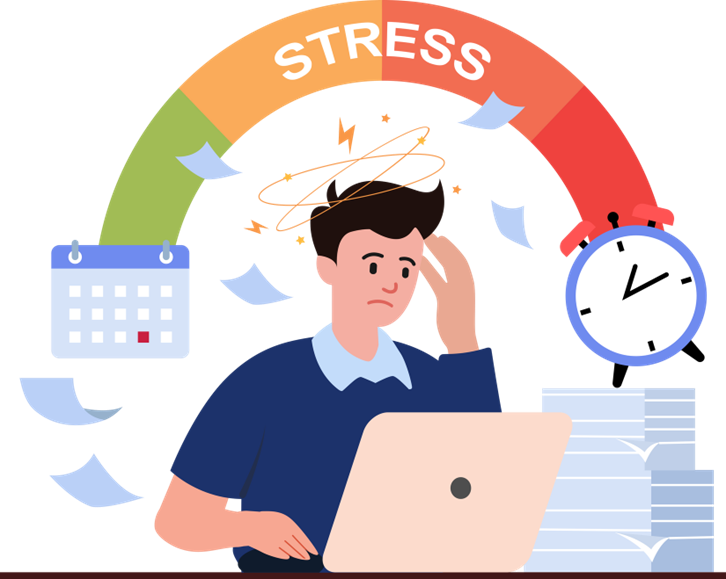Read Time: Approx 3 Min, 7 Secs
 Image Source: Thinking How
Image Source: Thinking How
Workplace stress is not just an inconvenience—it’s a health concern. In today’s fast-paced world, constant deadlines, long hours, and unclear expectations can lead to physical and emotional strain. While some stress is natural and can even boost performance in short bursts, chronic stress affects focus, mood, productivity, and long-term health. Fortunately, with the right strategies and support, it is possible to manage stress and build resilience at work.
This article explains what workplace stress is, why it matters, and what individuals and employers can do to reduce its impact.
Understanding Workplace Stress
Workplace stress occurs when job demands exceed a worker’s capacity to cope. According to the American Psychological Association (APA), common sources of stress include excessive workload, lack of control, limited social support, unclear expectations, and work-life imbalance. Over time, chronic stress can contribute to burnout, anxiety, depression, sleep disturbances, and even heart disease (APA, 2023).
The Centers for Disease Control and Prevention (CDC) highlights that stress doesn’t affect only mental well-being. It can also lead to physical symptoms such as headaches, fatigue, muscle tension, and digestive issues (CDC, 1999).
Why Managing Stress Matters
Ignoring stress doesn’t make it disappear. In fact, prolonged stress may reduce productivity, increase absenteeism, and strain workplace relationships. A tense environment can also cause higher turnover and lower morale across teams.
The Occupational Safety and Health Administration (OSHA) has recognized workplace stress as a serious occupational health issue. OSHA encourages employers to identify stressors early and promote a supportive work culture, noting that a mentally healthy workplace leads to better safety, engagement, and retention (OSHA, n.d.).
Practical Strategies for Individuals
Stress may be unavoidable at times, but there are practical steps you can take to minimize its effects:
- Set Boundaries:
APA recommends setting clear work-life boundaries, such as not checking emails after hours or during breaks. This helps the brain disconnect and recover from job demands.
- Take Microbreaks:
Short, regular breaks during the day help restore energy and focus. Even just standing, stretching, or walking for five minutes can reduce tension and improve circulation.
- Use Recovery Time Wisely:
Recovery isn’t just about resting—it’s about engaging in activities that replenish mental and emotional energy. Research from Harvard Business Review suggests that physical activity, social interaction, creative hobbies, and nature exposure are especially effective (HBR, 2022).
- Communicate Needs:
If work demands become overwhelming, speak with a manager or HR representative. Clear communication can lead to workload adjustments, role clarification, or access to support resources.
- Prioritize Sleep and Nutrition:
Stress management begins with basic self-care. Adequate sleep, hydration, and balanced meals stabilize mood and improve the body’s ability to handle pressure.
What Employers Can Do
Stress management is not just the employee’s responsibility. Employers play a critical role in creating healthier work environments. According to OSHA and the CDC, effective steps include:
Providing clear job expectations and fair workload distribution
Encouraging open communication and feedback without fear of retaliation
Offering mental health support, such as Employee Assistance Programs (EAPs) Creating a culture of respect, inclusivity, and recognition
Allowing flexible schedules or remote options when possible
When employers prioritize mental health, employees report higher engagement, better morale, and greater job satisfaction.
When to Seek Help
It’s important to recognize when stress becomes more than you can manage alone. Persistent anxiety, loss of motivation, irritability, or physical symptoms that interfere with daily functioning may signal the need for professional support. Speaking to a therapist, counselor, or medical provider can provide relief and tailored coping strategies.
Many workplaces now offer mental health services as part of their benefits package. Don’t hesitate to use them—they exist for a reason.
Final Thoughts
Workplace stress is a real and growing issue, but it doesn’t have to control your life. By setting boundaries, using recovery strategies, and building a supportive environment, both individuals and organizations can thrive. Surviving stress at work is not just about endurance —it’s about resilience, awareness, and proactive care.
Managing stress is an investment in your health and success—on and off the clock.
Sources Cited
American Psychological Association. (2023). Work Stress. https://www.apa.org/topics/healthy-workplaces/work-stress
Occupational Safety and Health Administration (OSHA). (n.d.). Workplace Stress:
Employer Guidance. https://www.osha.gov/workplace-stress/employer-guidance Harvard Business Review. (2022). How to Recover from Work Stress, According to
Science. https://hbr.org/2022/07/how-to-recover-from-work-stress-according-to-science Centers for Disease Control and Prevention (CDC) / National Institute for Occupational
Safety and Health (NIOSH). (1999). Stress…At Work (NIOSH Publication No. 99-101).
